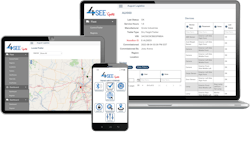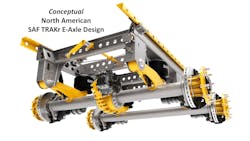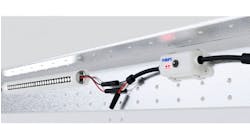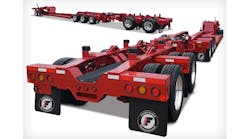Trailers’ jobs are pretty straightforward: Stay attached to the tractor, keep the cargo safe from point A to B, and don’t cause any downtime. Refrigerated units are also asked to keep their internal environments at a specific temperature. Simple, right?
But external pressures on fleets mean this isn’t good enough anymore. Any new equipment a fleet purchases needs to perform better than ever before. As fuel costs, freight rates, and just about everything else become more unpredictable, fleets need to know where their assets are and how they are doing at all times. That typically means adding smart technology that connects individual assets to the larger operation to provide their location and health, while also providing real-time and historical data.
Read more: Grote introduces smart trailer technology system“New technology continues to become more commonplace—there are steady increases across the industry in most items that will help reduce maintenance, increase fuel savings, or provide useful data to a customer operation,” said Sean Kenney, chief sales officer at Hyundai Translead.
Fleets are likely familiar with some smart features already, such as tire inflation system monitoring or GPS sensors to assist in asset tracking.
Now, using a system such as Utility Connect, a partnership between Utility Trailer and technology provider Phillips Connect that combines Utility’s wiring harness with Phillips Smart7 nosebox, they can also receive ABS fault codes and detect if trailer lights have gone out. On the operational side, they can verify if a trailer has cargo via cameras or ultrasonic sensors. And the system has the ability to evolve through over-the-air updates, which will allow management to communicate with other systems, such as Bendix roll-stability system or brake-pad wear sensors.
Other solutions include Aperia’s Halo Connect and Pressure System International’s TireView to monitor tire pressure and prevent blowouts and poor fuel economy, or ConMet’s PreSet Plus SmartHub to get data on hub, tire, and brake performance. And then there’s also Grote Industries’ 4SEE Smart Trailer System and Great Dane’s FleetPulse platform, which work similarly to Utility Connect. Reefer fleets can also adopt Thermo King’s TracKing telematics platform for end-to-end visibility on transport refrigeration units (TRUs).
The time is now
Industry experts at the American Transportation Associations’ Technology & Maintenance Council 2022 Fall Meeting noted that the buy-in from fleets to adopt more trailer connectivity technology is on the rise. Rob Phillips, founder and CEO of Phillips Connect, estimated by the end of 2023 there will be 350,000 smart trailers on the road, which will grow to 1,500,000 by 2026 and 2,000,000 by 2027.
Phillips Connect anticipates that in the next three years, seven out of every 10 new trailers will include some form of telematics, a number that will increase to more than 80% within the next five years. For its part, Phillips has delivered 150,000 smart-trailer gateways to customers, along with more than 1 million sensors that connect to them. The gateways, which include Smart7, StealthNet, and SolarNet, provide fleets with trailer health data and analytic tools.
Phillips noted these tools extend beyond answering the question “Where’s my trailer?” and allow fleets to identify which trailers are in need of maintenance and which are good to use. The company said its solutions have led fleets to dramatically improve trailer tire life and improve asset utilization.
“One OEM has told me that they are now putting telematics on nearly half of the trailers they ship out, and almost all of the reefers they build, and I would think that’s the same for other manufacturers,” Phillips said.
Particularly, Phillips found that the number of truck/trailer combos looking at overall health is increasing quickly.
“I believe we are approaching an inflection point now, where there are enough larger fleets that are talking about the benefits of smart trailers, and that this is creating a new level of momentum that will continue to increase adoption of truly smart trailer telematics, which is what we are excited about,” he said.
Lance Gage, SAF-Holland product manager of trailer axles & suspension systems, Americas, said SAF is definitely seeing an uptick in OEM partnerships and collaborations on smart trailers.
“The fleets are telling trailer OEMs and suppliers that they are ready for this new technology and that the OEMs are late to supply,” Gage said.
SAF supplies several smart trailer components in North America, including SAF Tire Pilot Plus and SAF automated coupling.
“It is not too much of a stretch to envision that all new trailers built in five to 10 years will have a suite of smart trailer options or levels from which to select that are likely tailored to their particular type of fleet application and needs,” Gage said.
He added that with the benefits of smart trailer connectivity being recognized, it is time to look to the future.
“More developments in the near term will monitor key operation parameters on the trailer and will greatly enhance overall safety and fleet operational performance,” Gage said. “How many times have we heard, ‘If I had only known,’ with regards to a pending trailer issue that could have likely been easily addressed in a safer manner more quickly and at a lower cost to the fleet?”
Drōv Technologies CEO Lisa Mullen said her team anticipates the adoption of smart or connected trailers will escalate, especially if fleets have set sustainability initiatives or autonomous goals. Drōv makes the AirBoxOne smart trailer platform, and partnered with SKF Vehicle Aftermarket to monitor vibration and temperature data at the wheel end monitoring.
“Smart trailers will need to be a part of [fleets’] decision-making now,” Mullen said. “As costs increase across the industry, the opportunities for savings through efficiencies—particularly tire savings—will become more pronounced.”
Nicola Zingraf-Bolton, head of digital solutions for the ZF Group CVS division in the Americas, said fleets are in the business of forwarding freight and “time is money.”
Trailer connectivity increases the efficiency of daily operations when it provides real-time load status and tracking information, she said.
“Continuously monitoring the trailer’s technical condition allows a fleet to remotely diagnose a fault and take appropriate action to minimize downtime,” Zingraf-Bolton explained. “Workshops use it to improve their service scheduling and preparations to get the vehicle back on the road faster.”
Ross Froat, executive director of Great Dane’s FleetPulse, said motor carriers are more interested in trailer connectivity technology today than they were back in 2016 or 2017. He said Great Dane saw an increase from competitors in 2019, especially with enhanced GPS tracking.
“A lot of things have changed because of COVID, and also that led to more attention on data and remote working,” Froat said. “You can log into FleetPulse—or our competitors—anywhere you are if you have a phone, laptop, or computer, and do asset management work right there, remotely.”
Connecting the benefits
More trailer health transparency should be a boon for any maintenance department. In general, having fewer tires to change out and overall trailers to manage will inevitably free up maintenance teams to focus more on critical issues. And with the help of telematics and data analytics, a trailer no longer has to rely on a human operator to discover its issues before they become full-blown disasters.
This may be most beneficial to the cold chain, where goods such as frozen foods can spoil if a TRU issue is not detected in time.
“Without telematics, the driver becomes solely responsible for setting the temperature and operating mode of the reefer unit correctly,” said Adam Jaberi, senior product owner of telematics and connected solutions at Thermo King. “Telematics not only provides a second set of eyes, but also additional validation that gives drivers and fleet managers peace of mind.”
He said even now, many in the industry don’t fully grasp the full potential of trailer connectivity, and mainly (at least in the reefer sector) use the sensors for location and temperature data. That changes shortly after implementation.
“After this honeymoon phase, customers start to realize that telematics can be used for more than looking at temperature and that it covers all aspects of fleet operations,” Jaberi said. “This is when customers start to ask questions about other use cases like dwell time reporting, geofencing capabilities, and customer reporting.”
He added the new data gleaned from trailer telematics can also reveal where a fleet is underperforming.
“Fleets will start using telematics thinking that they are performing at these record-breaking levels, and then the data shows that there is room for improvement,” Jaberi said. “Ultimately, this is a positive outcome that can lead to improvement. However, there are still reservations within different fleets to implement telematics because it uncovers areas like safety and fuel efficiency where there is still room for improvement.”
Steven Walters, senior product owner of telematics for Thermo King, said the company is seeing a different type of customer request telematics than in the past.
“For example, dry fleets that haven’t used telematics are realizing the benefits telematics provide,” he said, such as “a more holistic approach to monitoring their entire fleet.”
Trailer tires are also a frequent reason for breakdowns and costly repairs, making them the low-hanging fruit of smart trailer’s bountiful tree of benefits.
Jake Martin, marketing support specialist at Pressure Systems International (P.S.I.), said being able to find tires that are low or leaking allows fleets to prevent tire and wheel end events while also reducing fuel costs due to low inflation.
“A properly inflated tire has less rolling resistance resulting in better fuel economy, which is not only better for fleet costs, but is also better for the environment,” Martin noted.
While almost any fleet can benefit from using connected technology, he said the value is enhanced for fleets that run long hauls, or time-sensitive or expensive cargo. Trailer fleets that don’t have their own drivers pulling the trailers also see a tremendous value in having visibility to their assets when not in their possession, such as lease fleets and trailer pools, he added.
“The common denominator in all of this is to reduce the reliance on the driver in monitoring the health of various systems on the trailer and allowing them greater focus on driving,” Martin said.
Prepping for adoption and expansion
“A system that interconnects a trailer can help drive down operating costs,” said CJ Biank, global market manager at Grote Industries. “Potentially going into recession, you’re now protecting yourself because you’re ensuring that what you put on the road is operating most effectively and most efficiently.”
Biank said there is clearly a huge ramp up for trailer telematics, but now the early adopter fleets are looking for “more.”
“What is the nature of human beings—they want more, right?” Biank questioned. “They get something and they want more. This is where trailer connectivity adds on to telematics.”
“More” may include tying in ABS, lighting, and sensors and cameras.
“That’s where having some sort of standardized communication protocol is going to be so important for a trailer,” he added.
In the future, look for Grote and other providers to introduce ways to push for that smart trailer standardization. And they will need to address technology, sustainability, and operational goals along with improving connectivity.
“I think you’ll see fleets that have these types of goals are the ones that are the first adopters or the early adopters of this technology,” Biank said.
First adopters of smart trailers will likely include tanker fleets, said SAF’s Gage.
“As a highly weight-sensitive and safety-critical application, this makes the most sense for them to the initial adaptors,” Gage said. “We are seeing sensor integrations from tire pressure management, including load-based adjustments, to cameras for fuel discharge.”
When spec’ing these smart components, fleets should consider not only where technology is now, but how it will grow and improve.
“Fleets need to also understand the expandability of systems and whether or not their basic solution can accommodate additional integrations later on as they continue to evaluate whether or not these add-ons deliver an ROI to their operations,” P.S.I.’s Martin said.
Phillips agreed.
“Starting small with TPMS is a great way to begin saving, but as technology continues to quickly evolve, it’s never been more important to ‘future-proof’ your fleet to set yourself up for future success,” Phillips said. “Some fleets aren’t ready for that big investment in their trailers, but by starting with a capable harness and smart gateway, you have the ability to add sensors as you go.”
Grote’s 4SEE smart trailer system seeks to address this issue as a combination of hardware and software that gives truck fleets more access to data related to their operations.
“What we see with 4SEE is that it’s one system, one common communication stream,” Biank said. “That is the goal. What we want to do is create an infrastructure on that trailer that any type of component in today’s world or tomorrow’s world can tie into.”
Final considerations
Paul Washicko, general manager and VP of ConMet Digital, said pulling a trailer into a shop for equipment outfitting is no easy feat, so it could take a long time for a fleet to roll out smart trailer technology across its existing inventory.
And after that, having access to higher amounts of data can overwhelm management. Washicko noted some fleets soon realize they don’t have the proper processes or procedures in place to utilize this kind of visibility appropriately.
“[Fleets] dealt with these things in a reactionary way in the past, but now [if] you’ve got a tire issue, how do they work that into your normal operations?” Washicko asked. “Because that trailer has to be used as much as possible. We have to help the customers learn how to do that in their systems.”
According to Gage, preventing data overload is a focus at SAF-Holland.
“We work with each fleet to establish which attributes are of most concern and importance to them,” Gage said. “In addition, it’s important to determine the notification algorithms so that only actionable issues are communicated as alerts.”
Gage said as the market expands there will continue to be new signals and data integrators to manage for fleets.
When deciding which platform to invest in, customers should always strive for simplicity through consolidation.
“Fleets have been forced to deploy multiple systems on one asset to receive all the data points they need for their business, which drives cost for their monthly subscription services,” ZF Group’s Zingraf-Bolton said. “Telematics solutions that allow you to combine multiple features in just one system are key to control cost and significantly reduce installation complexity on a trailer.”
Froat says Great Dane is able to control the costs because it is a trailer manufacturer and its integration partners are willing and able to work with the team in a lot of different ways.
“There’s ease of advancing and more data integrating and more technology integrating into FleetPulse because of owning the trailer,” Froat said. “There are cons in the industry for data integration for partnering up and trying to create a product…for customers and to compete with large smart trailer suppliers.”
Biank said getting everyone to play nicely together in the trailer connectivity sandbox can be a challenge.
“With there being so many different platforms, so many different offerings on the trailer space, getting everyone to play nice together is very important,” Biank said. “We’ve taken a very agnostic approach to what we do. We’ve integrated all of the components that are on a trailer into our system. But we’ve also enabled [vendors] always to pull their data out. So when we talk back to accessibility… it’s not just the end user. It’s those vendors that you’re integrating…they want access to their own data.”









